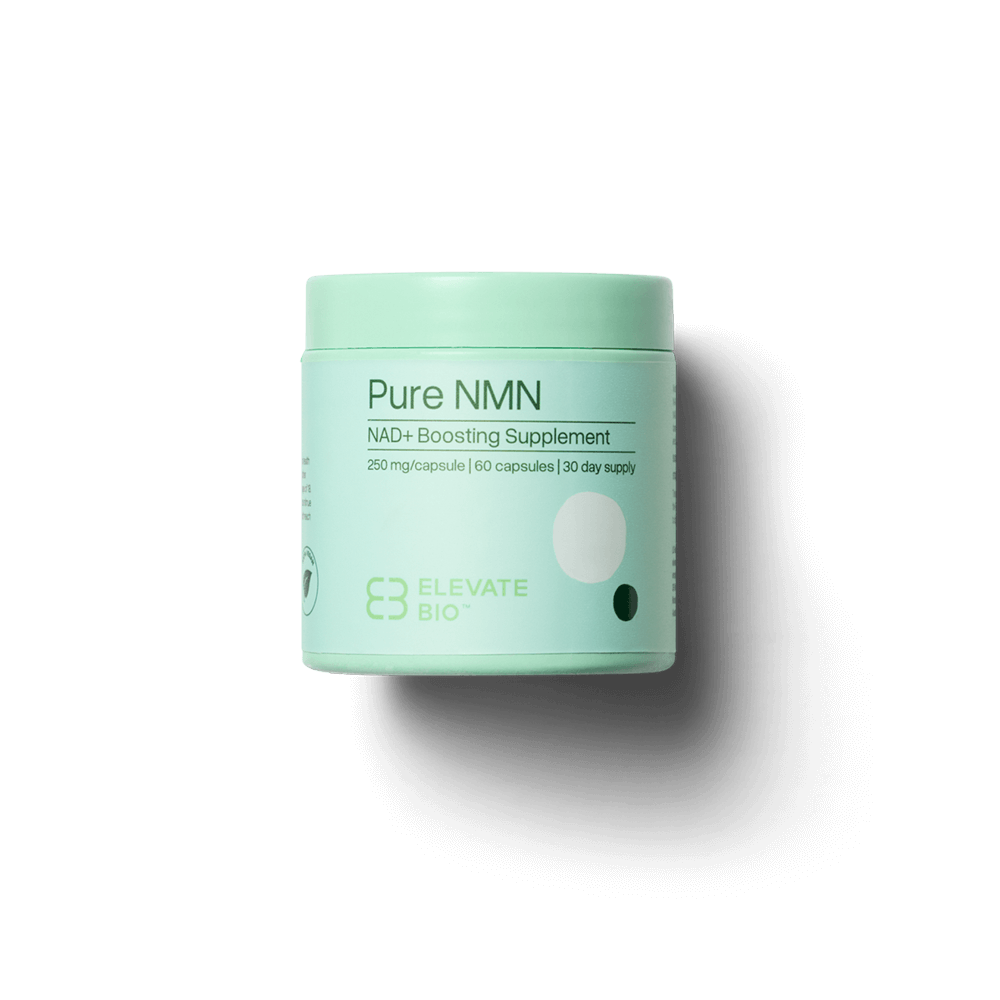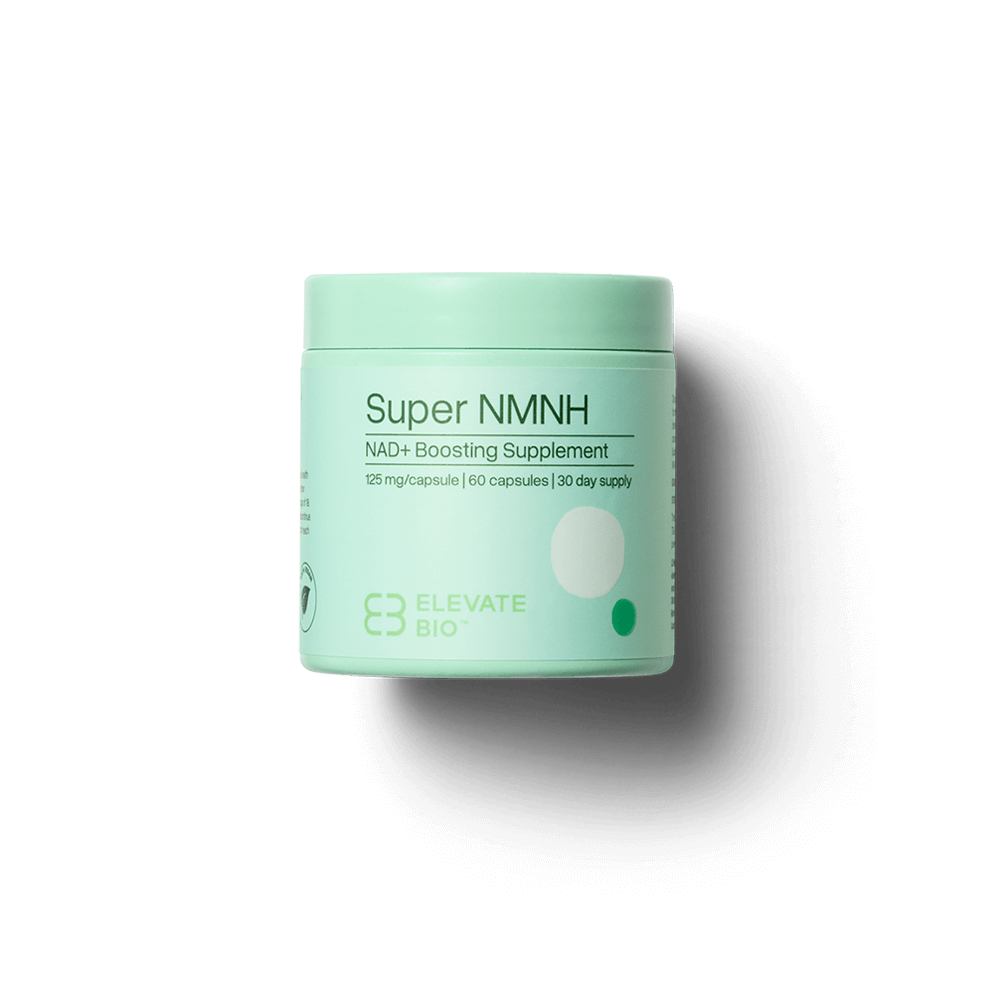“NAD+ is used by five hundred different enzymes. Without any NAD+, we’d be dead in 30 seconds”
– Dr. David Sinclair[i]
NAD+
Nicotinamide Adenine Dinucleotide, commonly known as NAD+ is one of the most important coenzymes found in the human body.[ii] NAD+ is derived from Vitamin B3, also known as niacin, through various biosynthetic pathways in cells. Found in the mitochondria of all living cells, the coenzyme is scientifically proven to boost the activity of all seven sirtuins.[iii] Sirtuins are a class of proteins that are NAD+ dependent, meaning they require NAD+ as a co-substrate to function properly. When NAD+ levels are high, sirtuins become more active, supporting cellular function.[iv]
In recent decades, NAD+ has gained significant global attention in biomedical research, due to its potential to improve cellular health, provoking implications for ageing, neurodegenerative diseases, metabolic disorders, and other health conditions.[v]
Essentially, NAD+ is responsible for various critical cell functions, including cell growth, metabolism, DNA repair, and ultimately, survival, making NAD+ levels scientifically recognised factors impacting the ageing process.[vi] This is due to the influence it has on the seven sirtuins.
As we age, the natural level of NAD+ in our body declines. Evidence demonstrates that NAD+ levels reduce by approximately 50% every 20 years. This suggests that when people are 50 years old, they are estimated to have half of the NAD+ as they did in their youth.[vii]
The reduction of NAD+ levels is associated with a wide range of ageing signs, including, metabolic disorders, neurodegenerative diseases, sleeping issues, depleted energy and wrinkles or ageing skin, muscle function and recovery and exercise performance.[viii]
Although NAD+ can be boosted by diet,[ix] it does not completely revive the inadequate levels. Nicotinamide Mononucleotide (NMN) and Dihydronicotinamide Mononucleotide (NMNH), which is Reduced NMN, both belong to the house of NAD+ boosting precursors, that support replenishing NAD+ levels in the body.[x]
A Deeper Dive into NAD+
The Molecular Structure:
NAD+ serves as a coenzyme found in all living cells, from simple bacteria to complex organisms like humans.[xi] Structurally, it consists of two nucleotides joined by phosphate groups.[xii] What renders NAD+ indispensable is its role as a mediator in redox reactions, facilitating the transfer of electrons between molecules during metabolic processes. This dual nature of NAD+—alternating between its oxidized (NAD+) and reduced (NADH) forms—makes it a versatile participant in cellular metabolism.[xiii]
Fuelling Cellular Energy:
One of NAD+’s primary roles lies in energy metabolism. Within the mitochondria, which is the powerhouse of the cell, NAD+ acts as a coenzyme in crucial reactions like glycolysis, the citric acid cycle, and oxidative phosphorylation. During glycolysis, glucose breakdown yields NADH, which carries high-energy electrons to the electron transport chain, driving ATP synthesis. In essence, NAD+ serves as a conduit for converting the chemical energy stored in nutrients into the currency of cellular energy, ATP.
Beyond Energy Production:
However, NAD+’s significance transcends mere energy production. It also serves as a co-substrate for various enzymes involved in DNA repair, gene expression, and cell signalling pathways.[xiv] For instance, enzymes such as sirtuins, which regulate cellular processes like gene transcription, apoptosis, and stress response, depend on NAD+ for their activity.[xv] Moreover, NAD+ plays a pivotal role in maintaining genomic stability by participating in DNA repair mechanisms, thus safeguarding cells against mutations and genomic aberrations.[xvi]
The NAD+ Decline
Despite its critical functions, NAD+ levels decline with age, a phenomenon linked to the ageing process and age-related diseases.[xvii] Factors like poor diet, chronic stress, and environmental toxins can further exacerbate this decline. Reduced NAD+ levels compromise cellular functions, impairing energy metabolism, weakening DNA repair mechanisms, and compromising cellular resilience.[xviii] Consequently, restoring NAD+ levels has emerged as a promising strategy for promoting health and longevity.
NAD+ stands as a foundation of cellular health, governing essential processes that sustain life. Its decline with age emphasises its significance in aging and age-related diseases, prompting interest in therapeutic interventions aimed at restoring NAD+ levels. As research continues to unravel the intricacies of NAD+ biology, we are armed with the most efficient NAD+ precursors, to ensure we maximise the potential of our NAD+ levels.
To shop our NAD+ boosting supplements, Pure NMN and Super NMNH click here!
References:
[i] Sinclair, D & LaPlante, M 2019, Lifespan: Why We Age – and Why We Don’t Have To, Harper Collins Publishers, Dublin, Ireland, pp. 134.
[ii] Bieganowski, P, & Brenner, C 2004 ‘Discoveries of Nicotinamide Riboside as a Nutrient and Conserved NRK Genes Establish a Preiss-Handler Independent Route to NAD+ in Fungi and Humans’, Cell, vol. 117, no. 4, pp. 495-502.
[iii] Sinclair, D & LaPlante, M 2019, Lifespan: Why We Age – and Why We Don’t Have To, Harper Collins Publishers, Dublin, Ireland, pp. 133-135.
[iv] Verdin, E 2014, ‘Sirtuins, NAD+, and Aging’, Trends in Endocrinology & Metabolism, vol. 25, no. 3, pp. 219-226.
[v] Sinclair, D & LaPlante, M 2019, Lifespan: Why We Age – and Why We Don’t Have To, Harper Collins Publishers, Dublin, Ireland, pp. 134.
[vi] ‘Recent research into nicotinamide mononucleotide and ageing’ 2022, Natural Portfolio, vol. 1, pp. 1.
[vii] Shade, C 2020, ‘The Science Behind NMN – A Stable, Reliable NAD+ Activator and Anti-Aging Molecule’, Integrative Medicine, vol. 19, no. 1.
[viii] ‘Recent research into nicotinamide mononucleotide and ageing’ 2022, Natural Portfolio, vol. 1, pp. 1.
[ix] Sinclair, D & LaPlante, M 2019, Lifespan: Why We Age – and Why We Don’t Have To, Harper Collins Publishers, Dublin, Ireland, pp. 135.
[x] Liu, Y, Luo, C, Li, T, Zhang, W, Zong, Z, Liu, X & Deng, H (2021), ’Reduced Nicotinamide Mononucleotide (NMNH) Potently Enhances NAD+ and Supresses Glycolysis, the TCA Cycle, and Cell Growth’, Journal of Proteome Research, vol. 20, no. 5, pp. 2596-2606.
[xi] Sinclair, D & LaPlante, M 2019, Lifespan: Why We Age – and Why We Don’t Have To, Harper Collins Publishers, Dublin, Ireland, pp. 134.
[xii] Shade, C 2020, ‘The Science Behind NMN – A Stable, Reliable NAD+ Activator and Anti-Aging Molecule’, Integrative Medicine, vol. 19, no. 1.
[xiii] Berg, J. M, Tymoczko, J. L, & Gatto, G. J 2019, ’Biochemistry‘, W. H. Freeman, ed. 9.
[xiv] Sinclair, D & LaPlante, M 2019, Lifespan: Why We Age – and Why We Don’t Have To, Harper Collins Publishers, Dublin, Ireland, pp. 133-135.
[xv] Sinclair, D & LaPlante, M 2019, Lifespan: Why We Age – and Why We Don’t Have To, Harper Collins Publishers, Dublin, Ireland, pp. 133.
[xvi] Sinclair, D & LaPlante, M 2019, Lifespan: Why We Age – and Why We Don’t Have To, Harper Collins Publishers, Dublin, Ireland, pp. 133-135.
[xvii] Sinclair, D & LaPlante, M 2019, Lifespan: Why We Age – and Why We Don’t Have To, Harper Collins Publishers, Dublin, Ireland, pp. 133-135.
[xviii] Sinclair, D & LaPlante, M 2019, Lifespan: Why We Age – and Why We Don’t Have To, Harper Collins Publishers, Dublin, Ireland, pp. 133-135.









